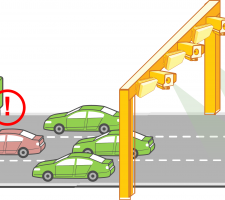
Electronic Vehicle Registration (EVR) shares much in common with large-scale city congestion charging, in that its benefits are numerous and obvious, and it has been a topic of lively discussion for a decade and more. Despite such manifest advantages and widespread interest, this has failed to translate into numerous large-scale deployments such as with congestion charging.
We have seen EVR projects in countries such as Brazil, Mexico and Thailand but no truly large-scale ‘success story’ as yet.
However, there are deployments which have been successful and from which lessons can be learned. In Bermuda, for instance, an 8% vehicle registration offence rate was halved just by the mere mention of the government’s intention to implement EVR.
Since that scheme went into operation, the offending rate has been halved again — proof that a well-publicised EVR scheme which is deployed in a correct fashion can have an appreciable effect.
Elsewhere, however, where success has been rather more limited, it is worth considering why — and how a different approach to deployment might have made a difference.
In some places, a lack of success can be put down to the government’s decision to take a stepped approach which did not involve the infrastructure-side systems which are necessary for the implementation to succeed. Instead, these authorities have concentrated solely on an initial distribution of tags — the ‘vehicle’ side of EVR. This misses the point that for EVR to be a success, a comprehensive — or at least workable — enforcement strategy is a necessity. More than one national government has committed such an error.
Elsewhere, difficulties have arisen for more politically motivated reasons. One is that EVR is not always seen as a top-level priority and so has suffered from a lack of political support, while another is the nature of some countries’ governmental structures. This is especially true where a national government has underneath it a series of state governments.
US politician Tip O’Neill’s adage ‘All politics is local’ is still true today some 80 years after he first uttered it. Nowhere is it more so than where the national governments’ revenue-raising or enforcement aspirations are devolved to the state level for implementation. EVR effectively forces compliance with vehicle registration and is therefore potentially unpopular as it costs people in some sections of society money which they may not have had to pay out before.
If it falls to the state government to bear the political fall-out of implementation then support can be unforthcoming - even more so if the state and national government are from different political parties. There is also the question of which level of government pays for the deployment of systems that support a national-level strategy.
Countering cloning
Such difficulties and prevarications are unfortunate, not least because EVR offers a unique opportunity to electronically and accurately register national vehicle fleets. It is especially useful in emerging economies where vehicle registration processes are not yet mature and databases of vehicles and owners/operators are inaccurate, incomplete or out of date, and where issues like license plate cloning are common due to a perceived lack of remediation. EVR also helps counter efforts to illegally reregister vehicles or drive without insurance.In many emerging economies, enforcement as is now practised simply does not work and avoidance of vehicle registration is not seen as a ‘major’ crime despite that association with license plate/vehicle identity cloning. It is also an unfortunate fact that, at the local level where vehicle inspections are carried out, fraud can be prevalent. Automation of the vehicle registration process can remove much of the human element and with it the potential for the exchange of cash to replace road safety.
The important thing to note about EVR is that it is a complete package. It is not just about procuring and distributing tags such that vehicles have a new ‘digital license plate’. It is also about the supporting infrastructure, database creation and management, and data-collecting capabilities. Most of all, there is no adequate business case for it without adequate means of enforcement.
The cost of enforcement need not be seen as particularly onerous — it is worth noting that for EVR to be successful the enforcement need not be as comprehensive, ‘watertight’ or expensive as, for instance, for tolling operations. There is no one-size-fits-all solution and the recipe is, as ever, a mix of fixed and portable solutions which introduce an element of unpredictability for potential offenders. Again, especially in emerging economies the majority of non-compliant road users break the law simply because there are no mechanisms in place to catch them - introduce the prospect of getting caught and compliance increases dramatically, as was proven in Bermuda. Companies such as Kapsch have long experience of enforcement/guaranteeing payment in tolling schemes and can help to optimise the enforcement solution.
Cost is undoubtedly a critical issue — especially in emerging markets. The distribution of tags for a national-level system is a major monetary undertaking but there are ways to mitigate this. In recognising a need to broaden their appeal, the major technology suppliers in the ITS sector are increasingly offering managed services and bring with them considerable expertise from various sectors which have direct application to EVR. Companies like Kapsch, for example, have a significant background in tag distribution and can bring certain business models and practises to bear which can help to minimise the financial burden. A lot of value can be gained in using a trusted business partner and in recognising both the initial gains and ongoing effects of less expensive, greatly simplified operations.
An experienced technology partner can also advise on the non-technical issues which can be the difference between success and failure. Many procuring authorities around the world make the mistake of assuming that by simply buying and implementing the technology, solutions such as EVR will somehow ‘work’. In the case of EVR (and other solutions), this assumption fails to take account of the relatively large number of stakeholders - especially by comparison with, for example, road tolling.
EVR is about vehicle registration and roadworthiness enforcement, tasks which typically involves Ministries of the Interior or similar organisations. This raises the need to consider the legal basis for implementing EVR, its relative importance politically and the fact that national government cannot necessarily ‘force’ lower levels of government to pursue implementation. In developed countries in the Western world, vehicle registration works well without EVR because the necessary legal processes are already in place. Therefore, where such processes are absent or not fully formed, gaining stakeholder alignment and a reappraisal of the legal system are important factors.
Getting enforcement right
On corridor schemes, where entry and exit point can be closely controlled, EVR enforcement can take the form of fixed solutions, whether overhead in gantries or on the hard shoulder. However, with other types of scheme, such as in free-flow environments or region-wide deployments featuring all types of roads, mobile and portable enforcement solutions may also be necessary.
Kapsch employs a range of solutions which allow spot check enforcement in free-flow traffic as well as manual enforcement at inspection areas, toll stations and border crossings.
For example, for free-flow applications it offers a van-mounted system with in-vehicle computer and printer; equipment for reading vehicles’ tags; a wireless local area network (WLAN) connection; and a direct universal mobile telecommunications system (UMTS) connection to a central management system. This solution is in service in several tolling schemes including those in Switzerland, the Czech Republic and Poland, and is also used by ASFiNAG, Austria’s national road operator.
Also available is a handheld tag reader. This mobile device features a WLAN connection to the van-mounted system but can also operate autonomously by being connected directly via UMTS to centralised databases.














